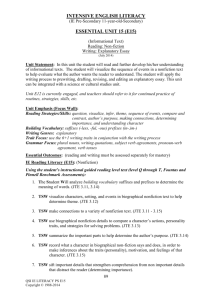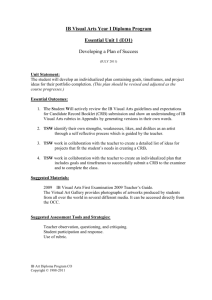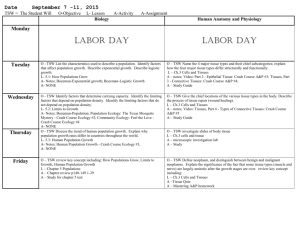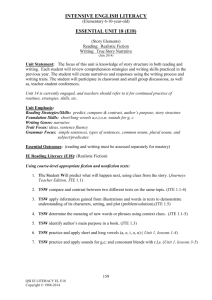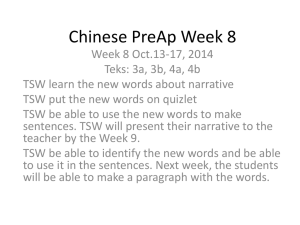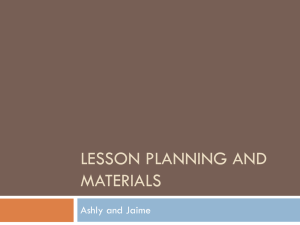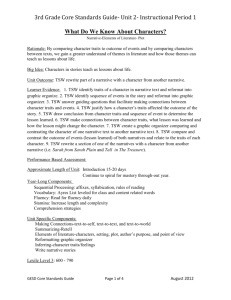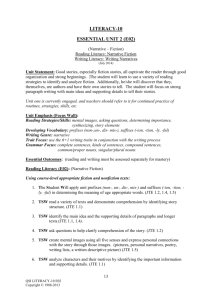LITERACY 7 E05
advertisement
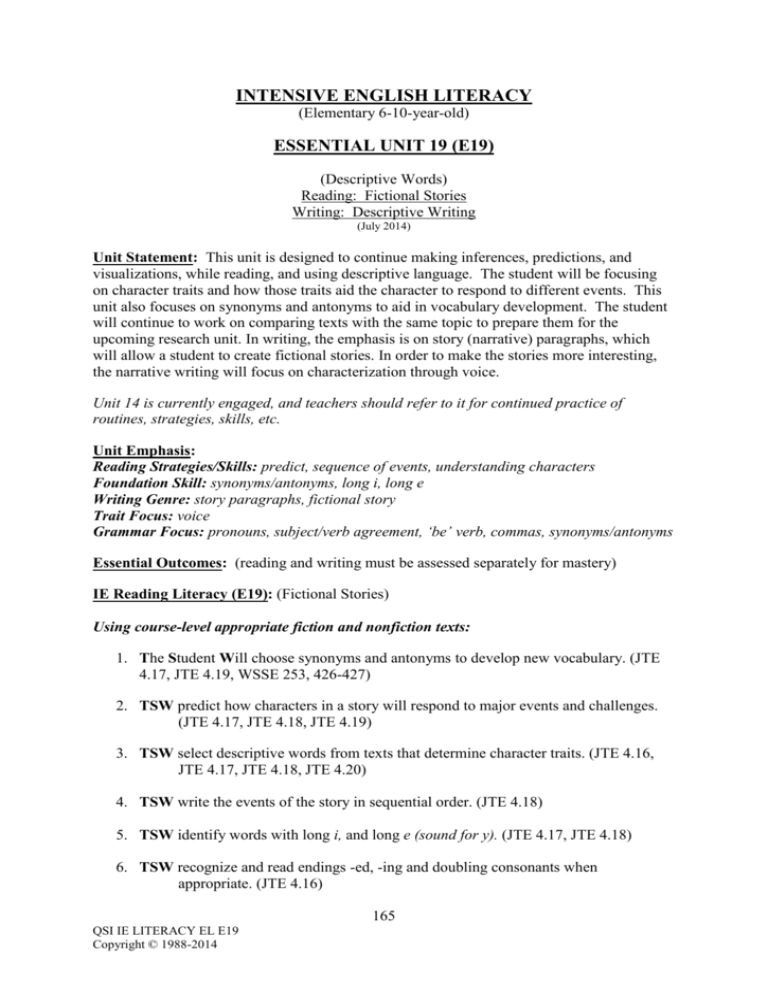
INTENSIVE ENGLISH LITERACY (Elementary 6-10-year-old) ESSENTIAL UNIT 19 (E19) (Descriptive Words) Reading: Fictional Stories Writing: Descriptive Writing (July 2014) Unit Statement: This unit is designed to continue making inferences, predictions, and visualizations, while reading, and using descriptive language. The student will be focusing on character traits and how those traits aid the character to respond to different events. This unit also focuses on synonyms and antonyms to aid in vocabulary development. The student will continue to work on comparing texts with the same topic to prepare them for the upcoming research unit. In writing, the emphasis is on story (narrative) paragraphs, which will allow a student to create fictional stories. In order to make the stories more interesting, the narrative writing will focus on characterization through voice. Unit 14 is currently engaged, and teachers should refer to it for continued practice of routines, strategies, skills, etc. Unit Emphasis: Reading Strategies/Skills: predict, sequence of events, understanding characters Foundation Skill: synonyms/antonyms, long i, long e Writing Genre: story paragraphs, fictional story Trait Focus: voice Grammar Focus: pronouns, subject/verb agreement, ‘be’ verb, commas, synonyms/antonyms Essential Outcomes: (reading and writing must be assessed separately for mastery) IE Reading Literacy (E19): (Fictional Stories) Using course-level appropriate fiction and nonfiction texts: 1. The Student Will choose synonyms and antonyms to develop new vocabulary. (JTE 4.17, JTE 4.19, WSSE 253, 426-427) 2. TSW predict how characters in a story will respond to major events and challenges. (JTE 4.17, JTE 4.18, JTE 4.19) 3. TSW select descriptive words from texts that determine character traits. (JTE 4.16, JTE 4.17, JTE 4.18, JTE 4.20) 4. TSW write the events of the story in sequential order. (JTE 4.18) 5. TSW identify words with long i, and long e (sound for y). (JTE 4.17, JTE 4.18) 6. TSW recognize and read endings -ed, -ing and doubling consonants when appropriate. (JTE 4.16) 165 QSI IE LITERACY EL E19 Copyright © 1988-2014 IE Writing Literacy (E19): (Descriptive Writing) 1. The Student Will identify the characteristics of a good narrative paragraph. (JTE 4.16, 4.17, 4.18) 2. TSW write narrative paragraphs by using the writing process. ( JTE 4.16, 4.17, 4.18) 3. TSW identify the characteristics of a fictional story. (JTE 4.19) 4. TSW write a fictional story by using the writing process. (JTE 4.19, 4.20, LC 1.2, 1.3, WSSE 70 - 89, LLG 362, 363) 5. TSW demonstrate the use of the writing trait, voice, in dialog and writing fictional narratives. (JTE 4.17, WSSE 366, 367, and LLG p. 336) 6. TSW correctly use pronouns, subject/verb agreement, the ‘be’ verb, and commas for dates, places and series in fictional stories. (JTE 4.16 - 4.20, WSSE 320 - 323, 328, 330, 331, 386 - 389, 342, 343) Introduced Outcomes: (taught, but not assessed) 1. The Student Will compare homographs/homophones and determine meanings. (JTE 4.16, WSSE 419 - 425) 2. TSW determine the qualities of the genre, realistic fiction. (JTE 4.16, 4.17) 3. TSW correctly change y to i (JTE 4.18) Practiced/Ongoing Outcomes: (ongoing development, but not assessed) 1. 2. 3. 4. 5. 6. 7. The Student Will acquire and use new vocabulary in reading, writing, and speaking. TSW demonstrate age appropriate spelling in their writing. TSW practice properly formed handwriting techniques. TSW compare and contrast two texts on the same topic. (JTE 4.16-20) TSW use illustrations to enhance meaning. (JTE 4.19) TSW practice using dictionaries and glossaries to edit informative writing. TSW use the word-processor for informative writing pieces. Key Terms and Concepts: Reading realistic fiction traits (character) descriptive/sensory Writing problem solution Suggested Materials for Teachers: (provided by school) *See Essential Unit 14 Journeys Language and Literacy Guide (see appropriate lesson) Suggested Professional Materials for Teachers: (provided by school) *See Essential Unit 14 166 QSI IE LITERACY EL E19 Copyright © 1988-2014 Suggested Exemplar Texts (read alouds): Scaredy Squirrel Series by Melanie Watt (Character Traits TSW 2-3) Lily’s Purple Plastic Purse by Kevin Henkes (Character Traits TSW 2-3) Hurricane by Jonathan London Fireflies by Julie Brinckloe The Boy Who Loved Words by Roni Schotter Additional Resources: (may not be provided by school) *see Essential Unit 14 Rigby Books: The Elves and the Shoemakers by Jeanne Willis, Is the Wise Owl Wise? by Shoo Rayner (Sequencing TSW 4) Technology Links: *See Essential Unit 14 Destiny Webpath Express (found in school library) http://www.scaredysquirrel.com/default2.html Character traits of Scaredy Squirrel (TSW #2-3) http://www.readworks.org/lessons/grade2/character/lesson-1 Character traits lesson (TSW #2-3) http://www.brainpop.com/educators/community/bp-jr-topic/synonyms-and-antonyms/ BrainPop subscription (if provided at your school) http://www.scholastic.com/teachers/top-teaching/2012/11/teaching-character-traits-readers-workshop Suggested Activities and Strategies: 1. Make a poster about a classmate that shows adjectives that would describe them as a character in a story. Suggested Assessment Tools: 1. Attached rubric or teacher-generated rubric that assesses ALL essential outcomes (TSWs). An effective rubric is presented and discussed with the student at the beginning of the unit, referred back to throughout the unit, and used to assess at the end. Students will collaborate with peers and the teacher to assess their own writing with final judgement by the teacher. 2. Writing Pathways (Units of Study Kit) by Lucy Calkins provides rubrics and checklists for teachers and students. 3. “6+1 Traits” writing rubrics 4. Teachers can have students produce a quick write at the beginning and end of units. (*See QSI Quick Write Guidelines) Teachers should keep these as evidence of students’ writing. 5. Elk Grove Common Core Rubrics for narrative, informative, and opinion writing are found in the QSI Literacy User’s Guide. Scoring on these rubrics should follow QSI mastery grading. (Scores on the 1 and 2 points should be P, scores on the 3 should be at the B level and scores on the 4 should be an A.) Document Source: Elk Grove Unified School District, Elk Grove, CA 6. Fountas and Pinnell Benchmark Assessment / DRA 7. QSI Reading and Writing Behaviors Checklists (*See QSI Literacy User’s Guide) 8. MPG (MAP for Primary Grades): Early Literacy Screening and Skills Checklists (*See QSI Literacy User’s Guide) RUBRIC FOUND ON FOLLOWING PAGE……………………… 167 QSI IE LITERACY EL E19 Copyright © 1988-2014 IE LITERACY EL Reading: Fictional Story Rubric (E19) Student Name: Date: ____________________________________ To receive a ‘B’ the student must show ‘B’ level mastery on ALL Essential Outcomes. (TSW’s) To receive an ‘A’, the student must show ‘A’ level mastery on ALL available and ‘B’ level mastery on all remaining TSW’s. ‘A’ Level TSW 1. choose synonyms and antonyms to develop new vocabulary. I can choose multiple synonyms and antonyms for the same word, using vocabulary above my grade level. 2. predict how characters in a story will respond to major events and challenges. 3. select descriptive words from texts that determine character traits. ‘B’ Level I can choose a synonym and an antonym to show my understanding of new words. I can predict how a character will respond to a problem in my story. I can select sensory words or descriptive words that infer what a characters personality traits and/or feelings are in the story. I can select descriptive words that tell me about a character. 4. write the events of the story in sequential order. I can put the story in order starting with the beginning, middle, and going to the end. 5. identify words with long i, and long e (sound for y). I can identify words with long i and long e sounds and pronounce these correctly while reading. 7. recognize and read endings -ed, ing and doubling consonants when appropriate. I can recognize words ending in -ed, and -ing and properly double the consonants when needed. 168 QSI IE LITERACY EL E19 Copyright © 1988-2014 ‘P’-Notes IE LITERACY EL Writing: Descriptive Writing Rubric (E19) Student Name: Date: ____________________________________ To receive a ‘B’ the student must show ‘B’ level mastery on ALL Essential Outcomes. (TSW’s) To receive an ‘A’, the student must show ‘A’ level mastery on ALL available and ‘B’ level mastery on all remaining TSW’s. ‘A’ Level TSW 1. Identify the characteristics of a good narrative paragraph. 2. Write narrative paragraphs by using the writing process. ‘B’ Level I understand that a good narrative paragraph needs an interesting topic sentence with several details and a closing sentence. I used descriptive words to make my paragraphs interesting and allowed my personality to show in my writing. My paragraphs are organized well. 3. Identify the characteristics in a fictional story. My paragraphs have a good beginning, some details and a problem and solution. I can follow the steps in the writing process to produce narrative paragraphs. I understand what the problem and solution are in fictional stories. 4. Write a fictional story by using the writing process. My story has good organization and focuses on one topic. I used descriptive words and many details to make my story more interesting. My story connects with readers in a unique way. 5. Demonstrate the use of the writing trait, voice, in dialogue and writing fictional narratives. I used many My writing sounds like I am expressions in my talking to someone. writing that shows my personality. I used a more mature writing style. 6. Correctly use pronouns, subject/verb agreement, the ‘be’ verb and commas for dates, places and series in fictional stories. I can write a fictional story with good organization and stick to one topic. My story has a problem and a solution. I can show the correct use of the ‘be’ verb, commas and pronouns in my paragraphs and stories. Most of my sentences have subject/verb agreement. 169 QSI IE LITERACY EL E19 Copyright © 1988-2014 ‘P’ - Notes

